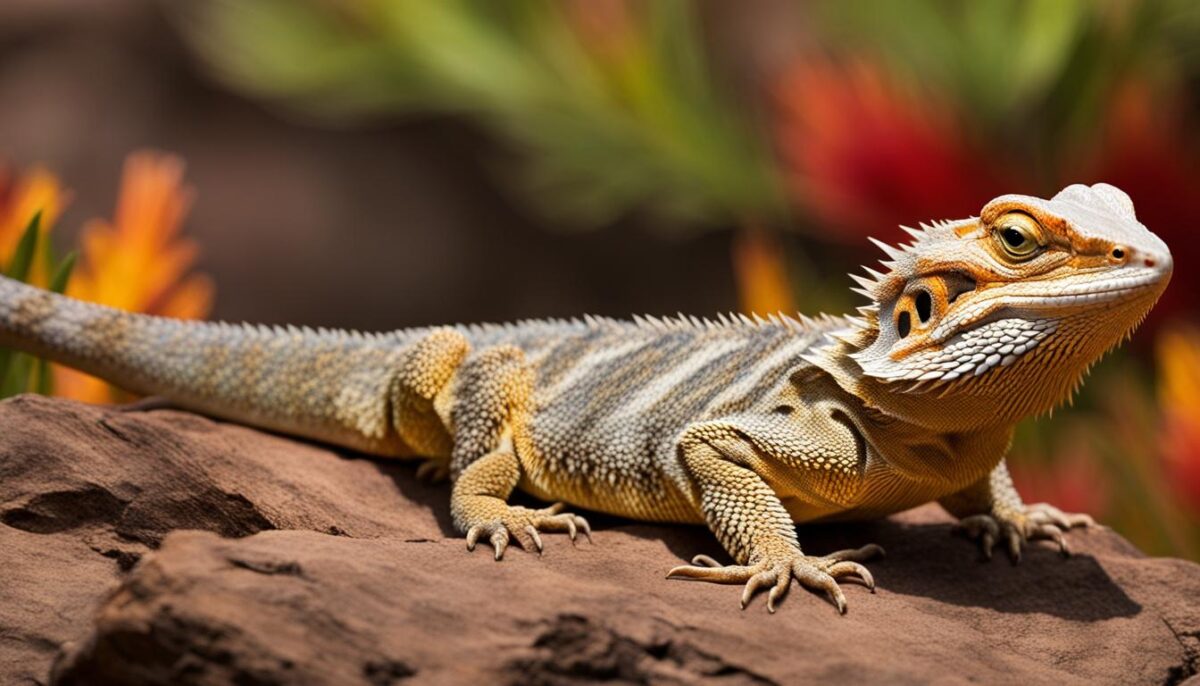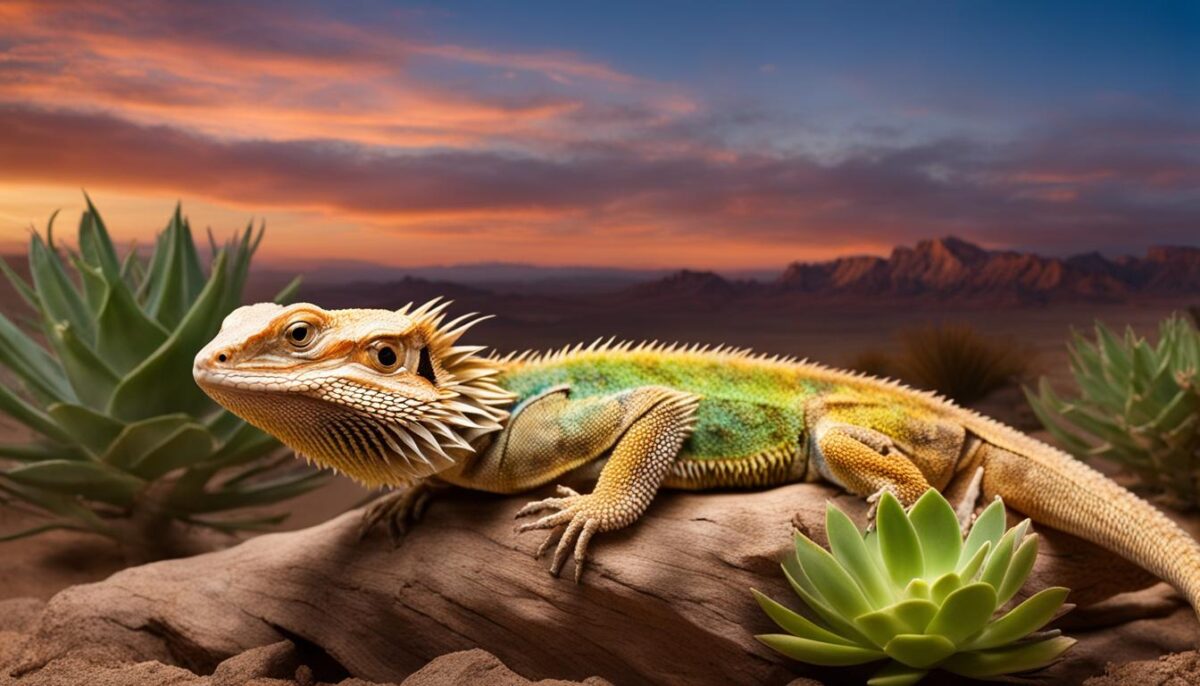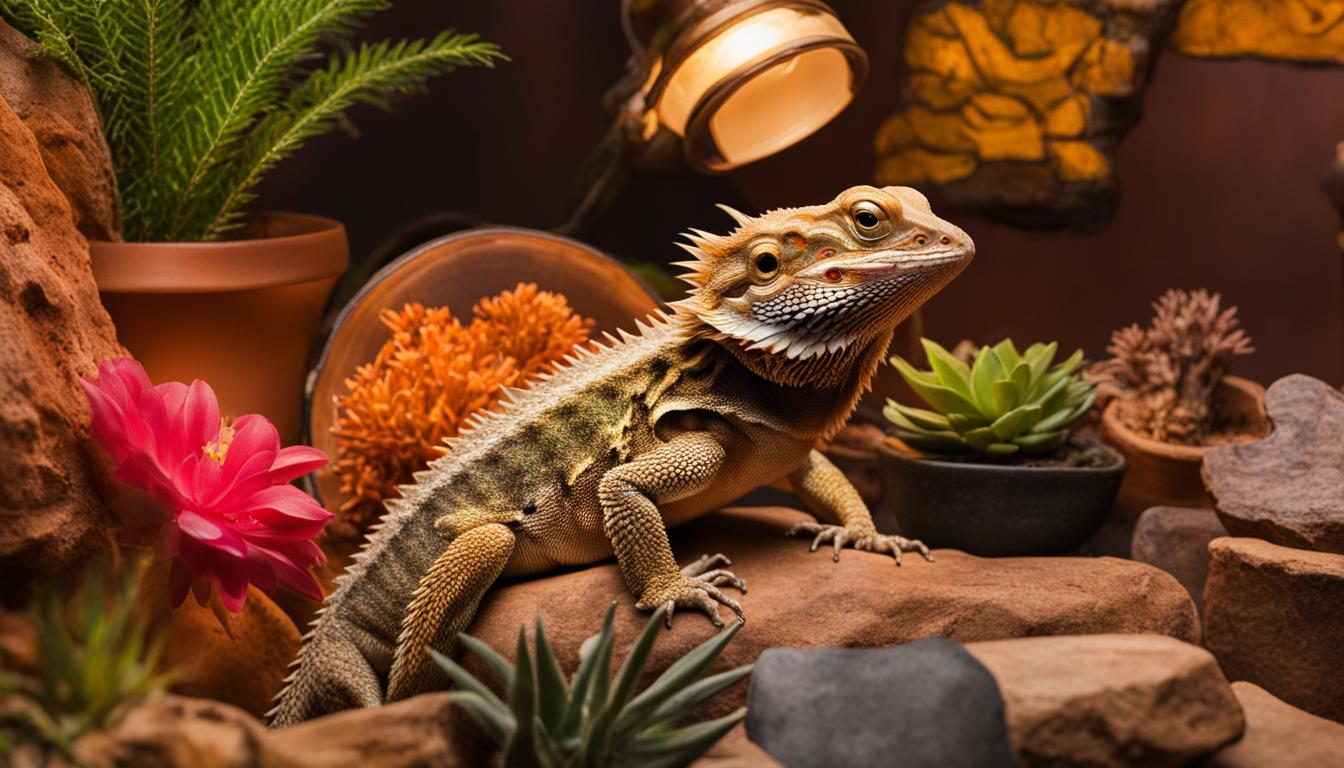Welcome to our comprehensive care guide for bearded dragons in Spanish, also known as “dragones barbudos”. Whether you are a beginner or an experienced reptile owner, this guide will provide you with essential tips for taking care of your Spanish-speaking bearded dragon. From their habitat setup to their diet, we will cover everything you need to know to ensure the well-being of your scaly friend.
Bearded dragons are fascinating reptiles that require proper care and attention. By understanding their specific needs and behaviors, you can create the perfect environment for your Spanish bearded dragon to thrive. Let’s dive into the details of caring for these amazing creatures!
Key Takeaways:
- Bearded dragons, or “dragones barbudos,” require proper care and attention.
- Creating the right habitat setup is crucial for their well-being.
- Their diet should consist of a balanced mix of live prey, leafy greens, vegetables, and occasional fruits.
- Handling them gently and providing a stress-free environment is essential.
- Regular veterinary check-ups and monitoring their behavior are necessary for their health.
Bearded Dragon Species in Spanish
There are several species of bearded dragons, or “dragones barbudos,” with the most common one being the Inland Bearded Dragon (Pogona vitticeps) in English. In Spanish, it is known as “Pogona del interior.” These reptiles have unique behaviors and habits. They are omnivores and can reach a size of up to 2 feet in length, with males typically growing larger than females. Understanding the species-specific traits of bearded dragons will help you provide them with the care they need.

Bearded dragons, or “dragones barbudos,” come in various species, but the most common one, known as “Pogona del interior,” exhibits fascinating characteristics. These reptiles are omnivores, meaning they consume both animal matter and plant material. Their diet consists of insects, fruits, vegetables, and leafy greens.
When it comes to size, bearded dragons can grow up to 2 feet in length, making them relatively large reptiles. Male bearded dragons usually reach a slightly larger size than females. Their impressive size adds to their charm and unique presence as pets.
Understanding the behavior of your Spanish bearded dragon is essential for providing appropriate care. These reptiles are known for their territorial nature and head-bobbing displays, which are a part of their social interactions. They also have specific temperature and lighting requirements to ensure their overall well-being.
Habitat Setup and Care in Spanish
Creating the right habitat for your Spanish-speaking bearded dragon is crucial for its overall well-being. When setting up their enclosure, consider the following:
- Size: The cage should be spacious enough to accommodate your bearded dragon. Ideally, it should be at least three times their snout-tail length. This ensures they have enough room to move around and explore.
- Hiding Areas: Bearded dragons need hiding areas to retreat to when they feel stressed or overwhelmed. Providing rocks, logs, or artificial caves in their habitat will give them a sense of security.
- Basking and Climbing: Sturdy branches or rocks should be included in the enclosure for your bearded dragon to climb on and bask under the heat source. This mimics their natural behavior and satisfies their need for heat and UVB exposure.
- Lighting: A full-spectrum light source is necessary for bearded dragons to absorb calcium effectively. This helps prevent nutritional deficiencies and bone-related issues. Position the light at an appropriate distance to provide the right amount of UVB radiation.
- Temperature: Maintaining the correct temperature gradient is vital for your bearded dragon’s health. The basking area should be around 100-110°F (38-43°C), while the cooler side should be around 80-88°F (27-31°C). Use a reliable thermometer to monitor the temperatures regularly.
- Water Access: Ensure your bearded dragon has access to clean, fresh water at all times. Place a shallow dish in the enclosure where they can drink and soak if desired. Regularly replace the water to maintain cleanliness.
- Cleaning and Hygiene: Regularly clean the enclosure to maintain a hygienic environment for your bearded dragon. Remove any waste, uneaten food, and debris. A clean habitat reduces the risk of infections and diseases.
Remember, providing a suitable habitat and proper care is essential for the well-being of your Spanish-speaking bearded dragon. By mimicking their natural habitat and meeting their specific needs, you can help ensure a happy and healthy life for your reptile companion.
| Key Habitat Elements | Description |
|---|---|
| Size | The cage should be at least three times the snout-tail length of your bearded dragon to provide adequate space for movement. |
| Hiding Areas | Include rocks, logs, or artificial caves for your bearded dragon to retreat to when they need privacy and security. |
| Basking and Climbing | Sturdy branches or rocks should be provided for climbing and basking, allowing your bearded dragon to mimic their natural behavior. |
| Lighting | Use a full-spectrum light source to provide the necessary UVB radiation for proper calcium absorption. |
| Temperature | Maintain a temperature gradient in the enclosure, with a basking area around 100-110°F (38-43°C) and a cooler side around 80-88°F (27-31°C). |
| Water Access | Ensure your bearded dragon has access to clean, fresh water at all times by placing a shallow dish in the enclosure. |
| Cleaning and Hygiene | Regularly clean the enclosure to maintain a hygienic environment and reduce the risk of infections and diseases. |

Bearded Dragon Diet in Spanish
A balanced diet is essential for the health of your Spanish bearded dragon. They are omnivores and require a combination of live prey, leafy greens, vegetables, and occasional fruits. Juveniles require a diet consisting mostly of live prey, such as crickets and worms, while adult bearded dragons should have a higher percentage of leafy greens in their diet. It is important to provide a variety of foods to ensure they receive all the necessary nutrients. Calcium supplements should also be included in their diet to prevent metabolic bone disease.
Feeding your Spanish bearded dragon a well-rounded diet is crucial for their overall health and vitality. As omnivores, their diet should consist of both animal and plant-based foods to meet their nutritional needs. Here are some key components to consider when planning their meals:
1. Live Prey:
Live prey such as crickets, mealworms, and dubia roaches should form a significant portion of the diet for juvenile bearded dragons. These protein-rich insects provide essential nutrients and help stimulate hunting behavior. Ensure the prey is appropriately sized and gut-loaded (fed nutritious food) before offering it to your bearded dragon.
2. Leafy Greens and Vegetables:
As your Spanish bearded dragon matures, the proportion of leafy greens and vegetables in their diet should increase. Offer a variety of vitamin-rich greens such as collard greens, turnip greens, and mustard greens. Vegetables such as squash, bell peppers, and carrots can also be included to provide additional nutrients.
3. Occasional Fruits:
While fruits should be offered in moderation due to their high sugar content, they can be included as an occasional treat. Offer small pieces of fruits like berries, melons, and apples to provide some variety and natural sugars.
4. Calcium Supplements:
Bearded dragons need calcium to support their bone development and overall health. Dusting live prey with a calcium supplement powder or providing calcium-rich foods like calcium-fortified insects, calcium-rich leafy greens, and cuttlebones will help prevent metabolic bone disease.
Remember to always provide fresh, clean water for your Spanish bearded dragon. Avoid using deep bowls as they may accidentally tip over and injure your pet. Instead, use shallow dishes or mist their enclosure to maintain hydration.
Creating a balanced diet that meets the nutritional needs of your Spanish bearded dragon is crucial for their overall well-being. Consulting with a reptile veterinarian or herpetologist is recommended to ensure you are providing the right diet based on your dragon’s age, size, and specific health requirements.
Tips for Owning a Bearded Dragon in Spanish
Owning a bearded dragon, or “dragón barbudo,” requires responsibility and proper care. These fascinating reptiles require a stress-free environment and gentle handling to thrive. Here are some essential tips for owning a bearded dragon in Spanish:
- Educate yourself: Learn about the specific needs and behaviors of bearded dragons to ensure you are well-prepared to care for them. Understanding their dietary requirements, habitat setup, and potential health issues will help you provide the best care.
- Regular veterinary check-ups: Schedule regular visits to a reptile veterinarian who is knowledgeable about bearded dragons. They can provide professional guidance, perform health checks, and address any concerns or issues that may arise.
- Proper hygiene: Maintain a clean and hygienic environment for your bearded dragon. Regularly clean their enclosure, including the substrate, food and water dishes, as well as any decorations. This helps prevent the buildup of harmful bacteria and ensures a healthy living space.
- Monitor behavior: Be observant of your bearded dragon’s behavior and habits. Changes in appetite, activity levels, or appearance can be early signs of potential health issues. Identifying any abnormalities early on can lead to prompt treatment and a better prognosis.
Remember, bearded dragons are unique creatures with specific care requirements. By following these tips, you can provide a happy and healthy life for your Spanish-speaking bearded dragon.
For more detailed information on bearded dragon care, please refer to the table below:
| Aspect | Key Points |
|---|---|
| Habitat Setup | Provide a spacious enclosure with hiding areas, climbing structures, and appropriate lighting and temperature gradients. |
| Diet | Offer a varied diet of live prey, leafy greens, vegetables, and calcium supplements to ensure proper nutrition. |
| Handling | Gently handle your bearded dragon to build trust and minimize stress. Support their body properly and avoid sudden movements. |
| Environmental Enrichment | Provide mental and physical stimulation through the use of toys, puzzles, and supervised outdoor time. |
Conclusion
Caring for bearded dragons, or “dragones barbudos,” in Spanish requires knowledge, dedication, and understanding of their specific needs. By providing the right care and attention, you can ensure the well-being of your Spanish-speaking bearded dragon.
Creating a suitable habitat is crucial for the overall health of your bearded dragon. Make sure to set up a spacious enclosure with hiding areas, sturdy branches for climbing and basking, and a full-spectrum light source. Maintaining the appropriate temperature and providing access to fresh water are also essential for their well-being.
When it comes to their diet, bearded dragons in Spanish require a balanced meal plan. Include a variety of live prey, leafy greens, vegetables, and occasional fruits in their diet. It’s important to provide calcium supplements to prevent metabolic bone disease and ensure their nutritional needs are met.
Don’t forget to monitor their behavior, seek veterinary assistance when needed, and always stay informed about the latest care tips. By following these guidelines, you can develop a rewarding and fulfilling relationship with your Spanish bearded dragon.
FAQ
¿Cómo se llaman los bearded dragons en español?
Los bearded dragons se conocen como “dragones barbudos” en español.
¿Cuáles son las especies de bearded dragons en español?
Existen varias especies de bearded dragons en español, siendo la más común el Pogona vitticeps, conocido en español como “Pogona del interior”.
¿Cómo puedo cuidar adecuadamente a mi dragón barbudo en español?
Para cuidar adecuadamente a un dragón barbudo en español, es importante crear un hábitat adecuado, proporcionar una dieta equilibrada y seguir consejos de cuidado adecuados.
¿Qué necesito para crear el hábitat adecuado para mi dragón barbudo en español?
Para crear el hábitat adecuado para un dragón barbudo en español, necesitas una jaula lo suficientemente grande, áreas de escondite, ramas resistentes para trepar y tomar el sol, y una fuente de luz de espectro completo. También es importante mantener la temperatura adecuada y proporcionar acceso a agua fresca.
¿Cuál es la dieta adecuada para un dragón barbudo en español?
La dieta adecuada para un dragón barbudo en español consiste en una combinación de presas vivas, verduras de hojas verdes, vegetales y frutas ocasionales. También es importante incluir suplementos de calcio en su dieta.
¿Cuáles son algunos consejos para cuidar adecuadamente a un dragón barbudo en español?
Algunos consejos para cuidar adecuadamente a un dragón barbudo en español incluyen manejarlos suavemente, proporcionar un ambiente libre de estrés, realizar revisiones veterinarias regulares, mantener la higiene adecuada y monitorear su comportamiento.


